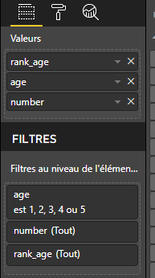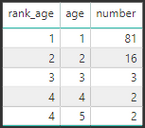FabCon is coming to Atlanta
Join us at FabCon Atlanta from March 16 - 20, 2026, for the ultimate Fabric, Power BI, AI and SQL community-led event. Save $200 with code FABCOMM.
Register now!- Power BI forums
- Get Help with Power BI
- Desktop
- Service
- Report Server
- Power Query
- Mobile Apps
- Developer
- DAX Commands and Tips
- Custom Visuals Development Discussion
- Health and Life Sciences
- Power BI Spanish forums
- Translated Spanish Desktop
- Training and Consulting
- Instructor Led Training
- Dashboard in a Day for Women, by Women
- Galleries
- Data Stories Gallery
- Themes Gallery
- Contests Gallery
- QuickViz Gallery
- Quick Measures Gallery
- Visual Calculations Gallery
- Notebook Gallery
- Translytical Task Flow Gallery
- TMDL Gallery
- R Script Showcase
- Webinars and Video Gallery
- Ideas
- Custom Visuals Ideas (read-only)
- Issues
- Issues
- Events
- Upcoming Events
The Power BI Data Visualization World Championships is back! Get ahead of the game and start preparing now! Learn more
- Power BI forums
- Forums
- Get Help with Power BI
- Desktop
- Help with SQL to DAX (subquery select from select)
- Subscribe to RSS Feed
- Mark Topic as New
- Mark Topic as Read
- Float this Topic for Current User
- Bookmark
- Subscribe
- Printer Friendly Page
- Mark as New
- Bookmark
- Subscribe
- Mute
- Subscribe to RSS Feed
- Permalink
- Report Inappropriate Content
Help with SQL to DAX (subquery select from select)
Hello,
I am having difficulty translating this SQL query with a subquery (SELECT FROM SELECT) to DAX:
SELECT Kids.[age]
,Kids.[number]
,Kids.[rank_age]
FROM (
SELECT ROW_NUMBER() OVER(ORDER BY COUNT([id_kid]) DESC) AS rank_age
,[age]
,COUNT([id]) AS number
FROM [dbo].[School]
WHERE [hair_color] in (3,4)
AND [age] in (1,2,3,4,5)
GROUP BY [age]
) as Kids
WHERE Kids.[age] = 4
What I am trying to do is to sort kids by age, count them, and establish a ranking.
I am using a subquery to be able to get the exact rank for certain age (for example 4) of the kids.
This is how I create the measure 'rank_age' in Power BI:
rank_age = RANKX ( ALLSELECTED ( Kids[age]) ; [number] )
And this is what I get by filtering on the age (1, 2, 3, 4 and 5):
What I now want to do is to use another filter to display only some of the ages, but maintaining the right ranks (the reason I'm using a subquery in the SQL script).
The result would be something like this (if I filter on the ages of 2 and 4):
I don't know which function to use in order to get the above result. Maybe it just can't be done with such method...
Any help would be very appreciated!
Thank you.
Solved! Go to Solution.
- Mark as New
- Bookmark
- Subscribe
- Mute
- Subscribe to RSS Feed
- Permalink
- Report Inappropriate Content
HI @benoit_chaceau,
You can try to use below formula if it suitable for your requirement:
Kids =
VAR summary =
SUMMARIZE (
FILTER (
ALL ( School ),
[hair_color] IN { 3, 4 }
&& [age] IN { 1, 2, 3, 4, 5 }
),
[Age],
"number", COUNT ( School[id_kid] )
)
RETURN
FILTER (
ADDCOLUMNS ( summary, "Rank", RANKX ( summary, [number],, DESC, DENSE ) ),
[age] = 4
)
If above not help, please share some sample data for test.
Regards,
Xiaoxin Sheng
- Mark as New
- Bookmark
- Subscribe
- Mute
- Subscribe to RSS Feed
- Permalink
- Report Inappropriate Content
HI @benoit_chaceau,
You can try to use below formula if it suitable for your requirement:
Kids =
VAR summary =
SUMMARIZE (
FILTER (
ALL ( School ),
[hair_color] IN { 3, 4 }
&& [age] IN { 1, 2, 3, 4, 5 }
),
[Age],
"number", COUNT ( School[id_kid] )
)
RETURN
FILTER (
ADDCOLUMNS ( summary, "Rank", RANKX ( summary, [number],, DESC, DENSE ) ),
[age] = 4
)
If above not help, please share some sample data for test.
Regards,
Xiaoxin Sheng
- Mark as New
- Bookmark
- Subscribe
- Mute
- Subscribe to RSS Feed
- Permalink
- Report Inappropriate Content
Hello @Anonymous
Thank you for your answer, it worked!
Now I have a better understanding of the SUMMARIZE function, thank you so much.
Regards,
Helpful resources

Power BI Dataviz World Championships
The Power BI Data Visualization World Championships is back! Get ahead of the game and start preparing now!

| User | Count |
|---|---|
| 39 | |
| 37 | |
| 33 | |
| 32 | |
| 29 |
| User | Count |
|---|---|
| 133 | |
| 88 | |
| 85 | |
| 68 | |
| 64 |




